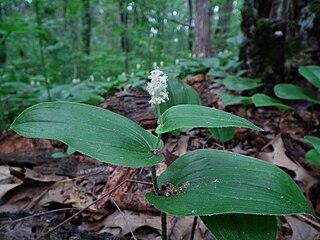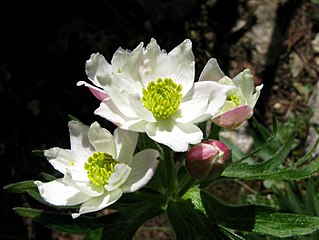
Primula is a genus of mainly herbaceous flowering plants in the family Primulaceae. They include the familiar wildflower of banks and verges, the primrose. Other common species are P. auricula (auricula), P. veris (cowslip) and P. elatior (oxlip). These species and many others are valued for their ornamental flowers. They have been extensively cultivated and hybridised - in the case of the primrose, for many hundreds of years. Primula are native to the temperate northern hemisphere, south into tropical mountains in Ethiopia, Indonesia and New Guinea, and in temperate southern South America. Almost half of the known species are from the Himalayas.

Zinnia is a genus of plants of the sunflower tribe within the daisy family (Asteraceae). They are native to scrub and dry grassland in an area stretching from the Southwestern United States to South America, with a centre of diversity in Mexico. Members of the genus are notable for their solitary long-stemmed flowers that come in a variety of bright colors. The genus name honors German master botanist Johann Gottfried Zinn (1727–59).

Magnolia grandiflora, commonly known as the southern magnolia or bull bay, is a tree of the family Magnoliaceae native to the southeastern United States, from Virginia to central Florida, and west to East Texas. Reaching 27.5 m (90 ft) in height, it is a large, striking evergreen tree, with large dark green leaves up to 20 cm long and 12 cm wide, and large, white, fragrant flowers up to 30 cm (12 in) in diameter.

Elaeagnus angustifolia, commonly called Russian olive, silver berry, oleaster, or wild olive, is a species of Elaeagnus, native to western and central Asia, Iran, from southern Russia and Kazakhstan to Turkey, parts of Pakistan and parts of India. As of 2020, it is widely established in North America as an introduced species.

Primula vulgaris, the common primrose, is a species of flowering plant in the family Primulaceae, native to western and southern Europe, northwest Africa, and parts of southwest Asia. The common name is primrose, or occasionally common primrose or English primrose to distinguish it from other Primula species also called primroses. None of these are closely related to the evening primroses.

Aquilegia coerulea is a species of flowering plant in the buttercup family Ranunculaceae, native to the Rocky Mountains from Montana south to New Mexico and west to Idaho and Arizona. Its common name is Colorado blue columbine; sometimes it is called "Rocky Mountain columbine," but this also refers to Aquilegia saximontana.

Dasylirion wheeleri is a species of flowering plant in the asparagus family Asparagaceae, native to arid environments of northern Mexico, in Chihuahua and Sonora and in the southwestern United States, in the Sonoran Desert in Arizona, and also in New Mexico and Texas.

Maianthemum canadense is an understory perennial flowering plant, native to Canada and the north-eastern United States, from Yukon and British Columbia east to Newfoundland, into St. Pierre and Miquelon. It can be found growing in both coniferous and deciduous forests. The plant appears in two forms, either as a single leaf rising from the ground with no fruiting structures or as a flowering/fruiting stem with 2-3 leaves. Flowering shoots have clusters of 12–25 starry-shaped, white flowers held above the leaves.

Primula elatior, the oxlip, is a species of flowering plant in the family Primulaceae, native to nutrient-poor and calcium-rich damp woods and meadows throughout Europe, with northern borders in Denmark and southern parts of Sweden, eastwards to the Altai Mountains and on the Kola Peninsula in Russia, and westwards in the British Isles.

Primula scotica, commonly known as Scottish primrose, is a species of flowering plant in the family, Primulaceae, the primroses and their relatives. It was discovered by James Smith, and is endemic to the north coast of Scotland.

Anemonastrum narcissiflorum, the narcissus anemone or narcissus-flowered anemone, is a herbaceous perennial in the genus Anemonastrum and the buttercup family. Basionym: Anemone narcissiflora Hook. & Arn.

Aquilegia saximontana, the Rocky Mountain columbine, alpine dwarf columbine, dwarf blue columbine, or alpine columbine, is a perennial plant that comes from the buttercup family, Ranunculaceae.

Scilla forbesii, known as Forbes' glory-of-the-snow, is a bulbous perennial plant from west Turkey flowering in early spring. It is considered synonymous with Scilla siehei, known as Siehe's glory-of-the-snow, by some sources, although others distinguish them. It belongs to a group of Scilla species that were formerly put in a separate genus, Chionodoxa, and may now be treated as Scilla sect. Chionodoxa. After flowering, it goes into dormancy until the next spring. It seeds readily to form colonies.

Linanthus pungens is a species of flowering plant in the phlox family known by the common names granite prickly-phlox and granite gilia. It is native to western North America from British Columbia to Baja California and east to Montana and New Mexico.

Dodecatheon austrofrigidum is a species of flowering plant in the primrose family known by the common names frigid shooting star and tundra shooting star. It is native to Washington and Oregon in the United States, where it grows in the coastal mountain ranges, including those on the Olympic Peninsula.
Townsendia rothrockii is a species of flowering plant in the aster family known by the common name Rothrock's Townsend daisy. It is endemic to Colorado in the United States, where there are 35 occurrences across thirteen counties. Reports of the plant from New Mexico are false.

The flora of the U.S. Sierra Nevada alpine zone is characterized by small, low growing, cushion and mat forming plants that can survive the harsh conditions in the high-altitude alpine zone above the timber line. These flora often occur in alpine fell-fields. The Sierra Nevada alpine zone lacks a dominant plant species that characterizes it, so may or may not be called a vegetation type. But it is found above the subalpine forest, which is the highest in a succession of recognized vegetation types at increasing elevations.
Iris afghanica is a plant species in the genus Iris, it is also in the subgenus Iris and in the section Regelia. It is a rhizomatous perennial, from Afghanistan, with thin bluish-green leaves and creamy yellow or white flowers, that are veined with purple-brown. It has yellow-green or purple beards. Although, in the wild, it can vary in colour and size. It is cultivated as an ornamental plant in temperate regions.

Primula amethystina is a species of flowering plant in the family Primulaceae, native to China. The plant is commonly found in west and northwest Yunnan and southwest Sichuan, and across the border in Tibet. It typically grows best in wet, boggy soil.

Asclepias angustifolia, commonly called the Arizona milkweed or talayote, is an endemic species of milkweed native only to Arizona.

















